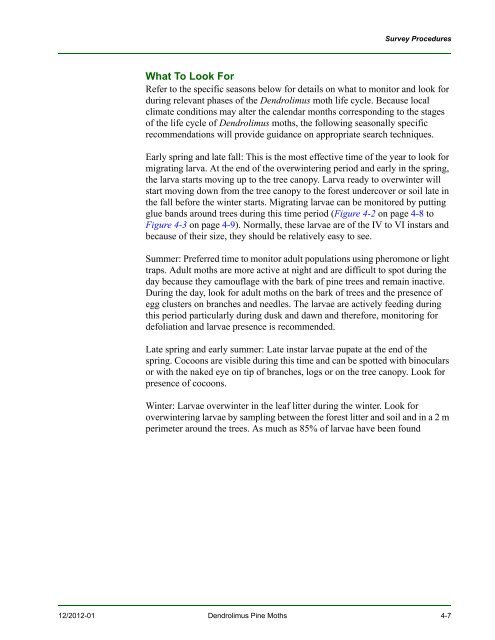New Pest Response Guidelines - aphis - US Department of Agriculture
New Pest Response Guidelines - aphis - US Department of Agriculture
New Pest Response Guidelines - aphis - US Department of Agriculture
Create successful ePaper yourself
Turn your PDF publications into a flip-book with our unique Google optimized e-Paper software.
Survey Procedures<br />
What To Look For<br />
Refer to the specific seasons below for details on what to monitor and look for<br />
during relevant phases <strong>of</strong> the Dendrolimus moth life cycle. Because local<br />
climate conditions may alter the calendar months corresponding to the stages<br />
<strong>of</strong> the life cycle <strong>of</strong> Dendrolimus moths, the following seasonally specific<br />
recommendations will provide guidance on appropriate search techniques.<br />
Early spring and late fall: This is the most effective time <strong>of</strong> the year to look for<br />
migrating larva. At the end <strong>of</strong> the overwintering period and early in the spring,<br />
the larva starts moving up to the tree canopy. Larva ready to overwinter will<br />
start moving down from the tree canopy to the forest undercover or soil late in<br />
the fall before the winter starts. Migrating larvae can be monitored by putting<br />
glue bands around trees during this time period (Figure 4-2 on page 4-8 to<br />
Figure 4-3 on page 4-9). Normally, these larvae are <strong>of</strong> the IV to VI instars and<br />
because <strong>of</strong> their size, they should be relatively easy to see.<br />
Summer: Preferred time to monitor adult populations using pheromone or light<br />
traps. Adult moths are more active at night and are difficult to spot during the<br />
day because they camouflage with the bark <strong>of</strong> pine trees and remain inactive.<br />
During the day, look for adult moths on the bark <strong>of</strong> trees and the presence <strong>of</strong><br />
egg clusters on branches and needles. The larvae are actively feeding during<br />
this period particularly during dusk and dawn and therefore, monitoring for<br />
defoliation and larvae presence is recommended.<br />
Late spring and early summer: Late instar larvae pupate at the end <strong>of</strong> the<br />
spring. Cocoons are visible during this time and can be spotted with binoculars<br />
or with the naked eye on tip <strong>of</strong> branches, logs or on the tree canopy. Look for<br />
presence <strong>of</strong> cocoons.<br />
Winter: Larvae overwinter in the leaf litter during the winter. Look for<br />
overwintering larvae by sampling between the forest litter and soil and in a 2 m<br />
perimeter around the trees. As much as 85% <strong>of</strong> larvae have been found<br />
12/2012-01 Dendrolimus Pine Moths 4-7

















